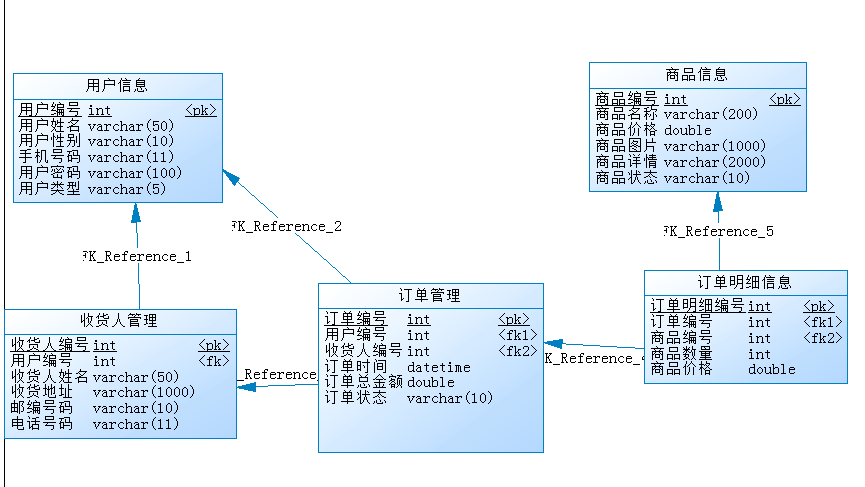數據庫SQL:
drop table if exists T_CartItems; drop table if exists T_Consignee; drop table if exists T_Goods; drop table if exists T_Order; drop table if exists T_OrderItems; drop table if exists T_User; drop table if exists T_comment; create table T_CartItems ( cartItems_id int not null auto_increment, goods_id int, user_id int, cartItems_count int not null, primary key (cartItems_id) ); create table T_Consignee ( consignee_id int not null, user_id int, consignee_name varchar(20) not null, consignee_phone varchar(11) not null, consignee_postcode varchar(6), consignee_address varchar(1000) not null, primary key (consignee_id) ); create table T_Goods ( goods_id int not null auto_increment, goods_name varchar(20) not null, goods_price double not null, goods_url varchar(10), goods_memo varchar(1000), goods_state varchar(10) comment '1.上架 2.下架', primary key (goods_id) ); create table T_Order ( order_id int not null, user_id int, consignee_id int, order_createTime datetime not null, order_bill double not null, order_state varchar(10) not null comment '1.待付款 2.已付款', primary key (order_id) ); create table T_OrderItems ( orderItems_id int not null auto_increment, goods_id int, order_id int, orderItems_name varchar(100) not null, orderItems_price double not null, orderItems_count int not null, primary key (orderItems_id) ); create table T_User ( user_id int not null auto_increment, user_pass varchar(100) not null, user_nick varchar(20) not null, user_name varchar(20) not null, user_phone varchar(11) not null, user_sex varchar(10) not null, user_type varchar(10) comment '1.普通用戶 2.管理員', primary key (user_id) ); create table T_comment ( comment_id int not null auto_increment, user_id int, goods_id int, comment_memo varchar(1000), comment_data datetime, primary key (comment_id) ); alter table T_CartItems add constraint fk_cartItems_goods foreign key (goods_id) references T_Goods (goods_id) on delete restrict on update restrict; alter table T_CartItems add constraint fk_cartItems_user foreign key (user_id) references T_User (user_id) on delete restrict on update restrict; alter table T_Consignee add constraint fk_consignee_user foreign key (user_id) references T_User (user_id) on delete restrict on update restrict; alter table T_Order add constraint fk_order_consignee foreign key (consignee_id) references T_Consignee (consignee_id) on delete restrict on update restrict; alter table T_Order add constraint fk_order_user foreign key (user_id) references T_User (user_id) on delete restrict on update restrict; alter table T_OrderItems add constraint fk_orderItems_goods foreign key (goods_id) references T_Goods (goods_id) on delete restrict on update restrict; alter table T_OrderItems add constraint fk_orderItems_order foreign key (order_id) references T_Order (order_id) on delete restrict on update restrict; alter table T_comment add constraint fk_comment_goods foreign key (goods_id) references T_Goods (goods_id) on delete restrict on update restrict; alter table T_comment add constraint fk_comment_user foreign key (user_id) references T_User (user_id) on delete restrict on update restrict;
本文出自 “老牛Java” 博客,請務必保留此出處http://liuyj.blog.51cto.com/2340749/1711450

